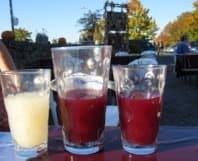The last of the Blacksmiths by Claire Gebben
As an American, I’ve always been inclined to lump “German food” into a predictable list: bratwurst, sauerkraut, and beer. Then I visited the Rhineland Palatinate (Pfalz) region of Germany to do research for my new novel, THE LAST OF THE BLACKSMITHS (Coffeetown Press, February 15, 2014), [Enter to win a copy below until Feb. 27.] and I gained an entirely different perspective. “German” food, it seems, has dishes as separate and unique from region to region as Boston Baked Beans are to Southern Creole Jambalaya. In the Palatinate, my palate savored such a delightful, rustic cuisine, I began to wonder if the words Palatinate and palate share a common Latin root.
Tucked into the southwestern corner of Germany between the Haardt Mountains to the west and the Rhine River to the east, the eastern Palatinate, in particular the Freinsheim Wine Route (or Deutsche Weinstraße), splays out in a stunning quilt of vineyards. Autumn is the time of the grape harvest, when the leaves are turning yellow to blanket the hills with a golden glow, a season known as Goldener Herbst by the Palatines.
Picturesque as it is, the Palatinate’s pleasant amenities–a milder climate, sprawling forests and rich, arable fields—have not spared its people an undue amount of conflicts and wars. The Thirty Years War, and a 1689 incursion by King Louis XIV of France, both decimated the region, forcing inhabitants to build again. Later still, in 1815, the House of Wittelsbach ruled the region, although the occupying Bavarians lived two duchies away in Munich.
Which brings me to what I have since learned: It turns out “palate” and “Palatinate” do not share the same Latin root. Palate comes from Palatum, “roof of the mouth,” while Palatinate derives from Palatinus, that is, of or relating to a palace, a term first bestowed when Romans ruled the region in feudal times. In the 1840s, King Ludwig of Bavaria found the region so attractive he too built a resplendent vacation villa. On his estate, called Ludwigshöhe, just outside the vineyard-rich region of Edenkoben, King Ludwig planted row upon row of chestnut trees.

Chestnuts
In early October, the prickly chestnuts litter the streets and grounds. Majestic chestnut trees grace not only Ludwigshöhe, but most villages and forests. The nuts crop up often in Palatine cuisine, as chestnut soup, and as a hearty chestnut-and-pork pie.
In season, chestnuts are even included in the stuffing of the signature Saumagen, that is, stuffed sow’s stomach. This traditional Palatine dish resembles American meatloaf—diced or ground ham, pork, onions, bread crumbs, eggs (and in season, chestnuts)—stuffed and tied into a cleaned, saltwater-soaked pig’s stomach casing and slowly simmered. Just like meatloaf, it’s served in slices. A favorite dish of former German Chancellor Helmut Kohl, himself a native of the Palatine region, Saumagen was even served as a delicacy to visiting heads of state, including Queen Elizabeth.
A traditional fall light supper enjoyed in the Palatinate is roasted chestnuts, onion cake, and “Neu Wein,” or new wine. The onion cake—or “leek tart,” if you prefer—conjures in the taste buds the stalwart fortitude of a people determined to bring dignity and artistry to life no matter the circumstances. The tart combines a thick bottom crust, layered with sautéed onions, eggs and cream. Always served during the grape harvest, the Palatines insist it must be savored with a glass of the region’s new wine.
Which brings me to another “best kept secret” of the Palatinate, their Neu Wein. Federweiß is another term for the uniquely satisfying new wine. In September and October at the time of the grape harvest, open air roadside stands unshutter in the villages, tables are set out, and Palatines arrive to sit and slake their thirst, or come toting glass gallon jugs, which are filled up with red or white new wine and carried home to enjoy with dinner.
The jugs are left uncorked, with only loose scraps of foil capping them. Why? New wine is “live wine,” like hard apple cider only with grapes, the fermentation process fizzing actively, even rapidly, within. At the roadside stands, new wine is always served in the ½ liter bubble glasses, another common sight in the Palatinate. A glass of red new wine is reminiscent of cherry juice, the white new wine tastes of golden sunlight. But watch out. The alcohol content tends to be high. Limit quantities accordingly, and keep jugs at home refrigerated to retard fermentation.
As evening dusk gathers, there’s something remarkable about sitting down to a Palatinate-style, light supper of onion cake, roasted chestnuts, and “new wine.”
Click here for Onion Cake and Chestnut Soup recipes
Guest Post
 Claire Gebben was born and raised on the southeast side of Cleveland, Ohio. After earning her BA in Psychology from Calvin College in Grand Rapids, Michigan, she eventually settled with her husband in Seattle. She’s worked as a newspaper columnist, newsletter editor, and ghostwriter, all the while raising a family and pursuing her first love of writing. In 2011, she earned an MFA in Creative Writing through the Northwest Institute of Literary Arts on Whidbey Island, WA. Her writing has appeared in Shark Reef, The Speculative Edge, Soundings Review, The Fine Line, and Northwest Prime Time. THE LAST OF THE BLACKSMITHS is her first novel. You can visit Claire’s website: http://clairegebben.com/ and follow her
Claire Gebben was born and raised on the southeast side of Cleveland, Ohio. After earning her BA in Psychology from Calvin College in Grand Rapids, Michigan, she eventually settled with her husband in Seattle. She’s worked as a newspaper columnist, newsletter editor, and ghostwriter, all the while raising a family and pursuing her first love of writing. In 2011, she earned an MFA in Creative Writing through the Northwest Institute of Literary Arts on Whidbey Island, WA. Her writing has appeared in Shark Reef, The Speculative Edge, Soundings Review, The Fine Line, and Northwest Prime Time. THE LAST OF THE BLACKSMITHS is her first novel. You can visit Claire’s website: http://clairegebben.com/ and follow her @ClaireGebben
Buy this Book!
Amazon







we are German, Belgium and French, we didn’t grow up eating onion cake or chestnut soup, just the usual foods you mentioned above, I would love to try these recipes, I have fresh chestnuts in my fridge that my mom gave me at Christmas – thanks for a chance to participat